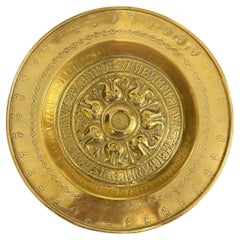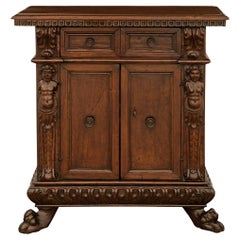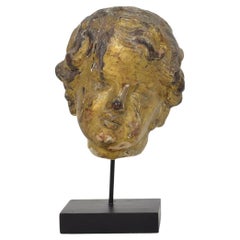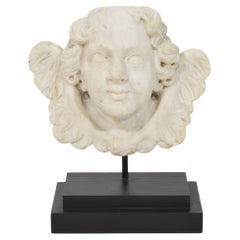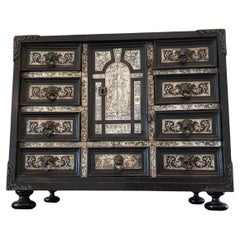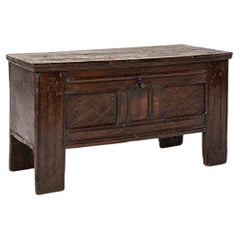17th Century Furniture
to
2,114
4,533
2,227
6,969
997
173
85
44
33
22
19
16
16
16
14
12
7
6
5
1
1
1
40,184
134,854
547,933
284,145
85,373
259,680
124,869
12,803
5,643
18,656
22,784
19,596
53,831
72,144
60,948
21,521
9,202
2,216
1,671
1,252
1,104
840
3,791
1,196
1,029
898
826
6,969
6,969
6,969
63
35
18
15
12
Period: 17th Century
17th Century Japanese Screen. Cranes and Peonies. Edo period.
Located in Kyoto, JP
Cranes and Peonies
Anonymous, Kano School.
Edo period, second half of the 17th century.
Six-panel Japanese screen. Ink, pigment gofun and gold leaf on paper.
This Japanese screen...
Category
Japanese Edo Antique 17th Century Furniture
Materials
Gold Leaf
Italian 17th 18th Century Carved Giltwood Baroque Angel Head
Located in Buisson, FR
Beautiful giltwood angelhead.
Italy, circa 1650-1750
Weathered and small losses.
Measurement here below inclusive the wooden base.
H:18,5cm W:11cm D:11,5cm
Category
Italian Baroque Antique 17th Century Furniture
Materials
Wood
$387 Sale Price
45% Off
Mid-size 6-panel byôbu 屏風 with a scene from The Tale of Genji
Located in Amsterdam, NL
A refined medium-sized six-panel byôbu (folding screen) showcasing a classical autumn court scene from chapter 7 of The Tale of Genji (Genji Monogatari), titled Momiji no Ga (The Aut...
Category
Japanese Antique 17th Century Furniture
Materials
Metal, Gold Leaf
Italian, 17th / 18th Century Carved White Marble Winged Angel Head Ornament
Located in Buisson, FR
Beautiful and unique handcarved white marble winged angel head ornament that once adorned a facade.
Italy, circa 1650-1750.
Weathered and small losses and old repairs/ restorations (...
Category
Italian Baroque Antique 17th Century Furniture
Materials
Marble
$1,486 Sale Price
49% Off
17th Century Italian Milano Renaissance Period Bone Ivory Ebony Tabletop Cabinet
Located in Forney, TX
A scarce nearly 400 year old fine quality Italian Lombard ebony rosewood bone and ivory tabletop curiosity cabinet with warm rich beautifully aged patina and interesting provenance. ...
Category
Italian Renaissance Antique 17th Century Furniture
Materials
Brass, Bronze
Antique 16th Century German Dark Brown oak carved Stollentruhe Trunk or Chest
Located in Casteren, NL
Rare and early German Stollentruhe, dating from around 1620. This compact 17th-century oak chest combines historical significance with visual prese...
Category
German Renaissance Antique 17th Century Furniture
Materials
Steel
Antique 17th century Italian Renaissance Solid Walnut handcarved Cassone Chest
Located in Casteren, NL
This richly carved wooden chest is a fine example of an Italian cassone from the 17th century. The cassone, also known as a bridal chest, was an essential piece of furniture in the h...
Category
Italian Renaissance Antique 17th Century Furniture
Materials
Iron
German Midcentury Pair of Glass Flush Mounts by WILA Leuchten, 1970s
By WILA
Located in Badajoz, Badajoz
Beauty and pretty Pair of Murano glass Flush Mounts or Wall Sconces by WILA Leuchten. These fixtures were designed and manufactured during the 1970s in Germany. Model 794.
Each Flush...
Category
German Mid-Century Modern Antique 17th Century Furniture
Materials
Metal
17th C. Painted Cabinet with Chalk, Graphite Panel Drawings, Turin, Italy
Located in Brooklyn, NY
An incredibly unique find on a hill top Villa in Turin, this cabinet has resided in the same home since its creation and hence is in remarkably good condition. The drawings and pain...
Category
Renaissance Antique 17th Century Furniture
Materials
Wood, Paint
White opaline Art Deco Flush Mounts
Located in Amsterdam, NL
1920s White opaline Art Deco Flush Mount
Metal glass holder with white porcelain bulb holder
Diameter glass holder 14 cm / 5.5 inches
Weight: 1.20 kg / 2.6 lb
Priced per individua...
Category
Belgian Art Deco Antique 17th Century Furniture
Materials
Brass, Iron
$335 / item
Very Rare Antique Armada Box or Strongbox in Iron Early 17th Century
Located in Meer, VAN
Very Rare Antique Armada Box or Strongbox in Iron Early 17th Century
A truly wonderful 400 year old museum worthy ‘strongbox’ or ‘armada box’. Most probably German, around 1600-1620...
Category
European Medieval Antique 17th Century Furniture
Materials
Iron
Pair of Extra Large J.T. Kalmar Wall Lights Smoked Glass, 1970
By J.T. Kalmar
Located in Rijssen, NL
XL Smoked glass wall lamps from the 1960s. Spectaculair design and high quality workmanship.
The light illuminates lovely due to the smoked and structured glass, it creates a spec...
Category
Austrian Mid-Century Modern Antique 17th Century Furniture
Materials
Metal
Madonna With Child Italian Painting Late 17th Century
Located in Milano, MI
Madonna and Child late 1600s, oil painting on canvas from northern Italy, in good condition, within walnut frame, from a private collection in Milan. The work depicts the Virgin hol...
Category
Italian Baroque Antique 17th Century Furniture
Materials
Canvas, Nutwood
Italian 16th/17th Century Small Iron Door Depicting Saint George
Located in Buisson, FR
Amazing period piece.
Beautiful small iron door that most likely once had its place in an Italian Chapel.
It is depicting Saint George killing the dragon. Beautiful naive style.
Ital...
Category
Italian Antique 17th Century Furniture
Materials
Iron
$2,935 Sale Price
38% Off
Alexander the Great, The Passage of the Granicus - Flemish Tapestry 17th -N 1503
Located in Paris, FR
Period: 17th century
Style: Rome and Antic Greece
Condition: Perfect condition
Material: Wool
Width: 465 cm
Height: 307 cm
Depth: 1 cm
In keeping with tradition, this magnificent ta...
Category
French French Provincial Antique 17th Century Furniture
Materials
Wool, Silk
Large Superb Quality Antique 17th Century Oak Gateleg Dining Table
Located in Suffolk, GB
Large superb quality antique 17th century oak gateleg dining table having a superb quality oak top with two oval drop leaves standing on square legs with double gatelegs united by sq...
Category
English Antique 17th Century Furniture
Materials
Oak
A Parallel of Antient Architecture with Modern by John EVELYN
Located in Middletown, NY
Evelyn, John translator; Fréart, Roland de Chambray
A Parallel of Antient Architecture with Modern,; In a Collection of Ten Principal Authors who have Written upon the Five Orders, P...
Category
English Antique 17th Century Furniture
Materials
Gold Leaf
17th.c French Tapestry Rare Verdure Original 239x330cm Fine Wool & Silk 8x11
Located in New York, NY
17th Century Antique French Tapestry Rare Verdure Fine Wool & Silk 8x11ft
"This is an incredible antique 17th century French tapestry...
Category
French Baroque Antique 17th Century Furniture
Materials
Wool, Silk
Mythical Atlantis Restored - A 1694 Map of the Americas and Ancient Geography
Located in Langweer, NL
This rare and fascinating map, titled "Atlantis Insula a Nicolao Sanson Antiquitati Restituta" by Guillaume Sanson, presents an unusual interpretation of the Western Hemisphere, comb...
Category
Antique 17th Century Furniture
Materials
Paper
1 of the 2 Opaline Large Glass Lamp "Water Lily" by Koch & Lowy for Peill & Putz
Located in Rijssen, NL
One of the two Large Pedant Ceiling lamp wave by Koch & Lowy for Peill & Putzler, Germany Düren 1960s.
Peill & Putzler's "Water Rose" (or "Artichoke") received the "iF Product Desig...
Category
German Post-Modern Antique 17th Century Furniture
Materials
Chrome
Fontana Arte Italian Midcentury Glass Brass Wall Lamp or Ceiling Lamp 1950s
By Fontana Arte
Located in Reggio Emilia, IT
Italian midcentury modern design large ceiling lamp or sconce wall lamp produced by Fontana Arte with brass structure and textured glass diffuser.
Italy 1950s
Please note that the l...
Category
Italian Mid-Century Modern Antique 17th Century Furniture
Materials
Brass
Rembrandt Van Rijn (1660-1669) Reproduction GHI.M.A Authorized
Located in Taranto, IT
Rembrandt Van Rijn (1606-1669) Reproduction GHI.M.A Authorized
Measures:
Height 57 cm
Width 68 cm
Technique oil on canvas
The company GHI.M.A. certifies that the relief, the app...
Category
Italian Antique 17th Century Furniture
Materials
Canvas
$1,002 Sale Price
66% Off
Engraving of a Ceremonial Gathering in New Spain in New Spain by Montanus, 1673
Located in Langweer, NL
This detailed copper engraving originates from Arnoldus Montanus' "Die Unbekannte Neue Welt oder Beschreibung des Welt-teils Amerika und des Sud-Landes", depicting a ceremonial gathering in New Spain...
Category
Dutch Antique 17th Century Furniture
Materials
Paper
$377 Sale Price
30% Off
French Louis XIV Period 'Arms of France' Fireback / Backsplash, 17th Century
Located in Soest, NL
17th century French Louis XIV Period fireback with the Arms of France. A coat of arms of the House of Bourbon, an originally French royal house that became a major dynasty in Europe....
Category
French Louis XIV Antique 17th Century Furniture
Materials
Iron
French 17th Century Baroque Wooden Madonna with Child
Located in Buisson, FR
Lovely hand carved wooden Madonna with child with traces of old color. Despite of the fact this piece has several losses , she has a wonderful and strong expression and beautiful old...
Category
French Antique 17th Century Furniture
Materials
Wood
$952 Sale Price
45% Off
Large 16th-17th Century Flemish tapestry
Located in Henley-on Thames, Oxfordshire
An important LARGE Flemish tapestry
16th-17th century
Old Testament subject of King Solomon, standing before his tent in armour and receiving a gift of two peacocks, from an old m...
Category
Belgian Baroque Antique 17th Century Furniture
Materials
Textile
Antique English 17th Century Charles I Carved Oak Court Cupboard Cabinet 1630
Located in Portland, OR
An important antique English Jacobean carved oak court cupboard, from the reign of King Charles I, dated 1630.
The rectangular overhanging top with a carved arcaded frieze, to the ce...
Category
English Jacobean Antique 17th Century Furniture
Materials
Oak
Momoyama period Japanese Screen. Crows on Pine. Studio of Hasegawa Tohaku.
Located in Kyoto, JP
Studio of Hasegawa Tohaku (1539-1610)
“Crows on Pine”
Momoyama period. Early 17th Century.
A six-panel Japanese Screen. Ink on paper.
The early 17th century Momoyama period scree...
Category
Japanese Medieval Antique 17th Century Furniture
Materials
Paper
Pair of Chinese Ming Sancai Dragon Roof Tiles, c. 1650
Located in Chicago, IL
This incredible pair of sancai-glazed Chinese roof tiles were once installed as part of the elaborate roof of a Ming-dynasty temple or grand courtyard home. Dated to the 17th century...
Category
Chinese Ming Antique 17th Century Furniture
Materials
Earthenware
Early Antique Engraved Silver Crucifix, Reliquary Cross Box Pendant 17th Century
Located in Bristol, GB
ANTIQUE SILVER CRUCIFIX/LATIN CROSS
A striking and decorative piece made from continental silver with a central crucifix engraved with a fairly naive depiction of Christ.
The centr...
Category
Spanish Renaissance Antique 17th Century Furniture
Materials
Silver
Chinese Ming Dynasty Ko-Sometsuke Wucai Porcelain Plate
Located in Newark, England
CHONGZHENG 1628-1644
From our Chinese collection, we are delighted to offer this rare example Chinese Ko-Sometsuke Wucai Porcelain Plate. The plate potted in porcelain ceramic of ci...
Category
Chinese Ming Antique 17th Century Furniture
Materials
Ceramic, Porcelain
1 of the 3 Murano Yellow Brown and Orange Glass Pendant Light, 1960s
Located in Rijssen, NL
1 of the 3 Doria Leuchten globes (in collaboration with Murano) in the style of Venini, manufactured, circa 1960. Real statement piece.
High-end thick Murano crystal glass shades ma...
Category
German Mid-Century Modern Antique 17th Century Furniture
Materials
Brass
French, 17th/ 18th Century, Forged Iron Weathervane
Located in Buisson, FR
Unique hand forged iron weathervane. Beautiful eyecatcher, France, circa 1650-1750. Weathered. Measurement here below is inclusive the wooden base.
H:74cm W:32cm D:11,5cm
Category
French French Provincial Antique 17th Century Furniture
Materials
Iron
$686 Sale Price
41% Off
Antique 2ft French Box Wood Corpus Christi Olive Wood Cross & Base 17th Century
Located in London, GB
This is a distinctive antique French patinated boxwood altar Corpus Christi of Christ crucified on an olive wood cross, dating from the late 17th Century.
The details are very impressive, the Corpus Christi is very life-like, wearing a flowing linen cloth, his eyes closed and head upper-turned and raised on a stepped base.
The craftsmanship is second to none throughout all aspects of this magnificent altar Corpus Christi which is sure to add an unparalleled touch of sacred art to your home.
Condition:
In good condition. As an antique item, the piece shows signs of use commensurate with age, these minor condition issues are mentioned for accuracy and, as seen in the accompanying photographs, it displays beautifully.
Dimensions in cm:
Height 64 cm x Width 26 cm x Depth 13 cm
Dimensions in inches:
Height 2 feet, 1 inch x Width 10 inches x Depth 5 inches
The Christian cross, seen as a representation of the instrument of the crucifixion of Jesus, is the best-known symbol of Christianity. It is related to the crucifix (a cross that includes a corpus, usually a three-dimensional representation of Jesus' body) and to the more general family of cross symbols, the term cross itself being detached from the original specifically Christian meaning in modern English (as in many other western languages).
The basic forms of the cross are the Latin cross with unequal arms (✝) and the Greek cross (✚) with equal arms, besides numerous variants, partly with confessional significance, such as the tau cross...
Category
French Antique 17th Century Furniture
Materials
Olive
Antique Pewter Spoons On Custom Stand
Located in San Juan Capistrano, CA
Antique Pewter Spoons On Custom Stand, set includes a custom wooden stand, markings on the spoon suggest they are European possibly from the 17th ...
Category
Antique 17th Century Furniture
Materials
Pewter
$375 Sale Price
50% Off
Antique Persian Safavid Dynasty Embroidered Textile
Located in Queens, NY
An antique Persian Iranian Safavid dynasty hand woven embroidered textile wall hanging. The textile is adorned with a traditional paisley ornament. Circa: 17th century to 18th centur...
Category
Unknown Antique 17th Century Furniture
Materials
Textile
$604 Sale Price
40% Off
Antique Ming Period Kraak Tokkuri Sake Bottles Kosometsuke Landscape Chinese
Located in Amsterdam, Noord Holland
Excited and really happy to share these 2 pieces.
Pair of Chinese Blue and White Porcelain Tokkuri (Sake Bottles)
Jingdezhen kilns, Early 17th century (Late Ming dynasty), made for...
Category
Chinese Ming Antique 17th Century Furniture
Materials
Porcelain
French 17th Century carved Wooden Folding Lectern In Gothic Style
Located in Buisson, FR
French 17th Century carved Wooden Folding Lectern In Gothic Style.
Beautiful piece made out of oak and wrought iron.
France circa 1600-1700.
Weathered, small losses and old repair.
M...
Category
French Gothic Antique 17th Century Furniture
Materials
Iron
$1,372 Sale Price
46% Off
17th century Oak Credence table
Located in Malton, GB
This is a stunning totally original 17th century Credence table. This is made entirely from oak and shows its age handsomely. The form of the table is hugely attractive and its neat ...
Category
Antique 17th Century Furniture
Materials
Oak
French, 17/ 18th Century Hand Forged Iron Candleholder
Located in Buisson, FR
Very old and beautiful hand forged iron candleholder.
France, circa 1650-1750. Weathered.
Category
French French Provincial Antique 17th Century Furniture
Materials
Iron
$471 Sale Price
54% Off
6x10 17th Century Antique Tapestry Large Antique French Tapestry Wool & Silk
Located in New York, NY
17th. Century rare antique French tapestry fine wool & silk 5'9" x 10' (6' x 10')
175cmx305cm
"This is a very fine high quality rare authentic Antique French Tapestry made wit...
Category
French Baroque Antique 17th Century Furniture
Materials
Wool, Silk
$21,260 Sale Price
20% Off
Antique 17th Century English Quartersawn Oak Sideboard Server Court Cupboard
Located in Dayton, OH
A beautiful English Charles II era sideboard or server, circa 1660s. Reminiscent of the Jacobean era Court Cupboard. Made from quartersawn oak with intric...
Category
Charles II Antique 17th Century Furniture
Materials
Brass
$4,000 Sale Price
20% Off
Large 17/18th Century Italian Carved Carrara Marble Baroque Angel Fragment
Located in Buisson, FR
Beautiful weathered marble baroque angel.
Italy 17/18th century. Weathered, losses and old repairs.
More pictures are available on request.
Category
Italian Baroque Antique 17th Century Furniture
Materials
Carrara Marble
$6,864 Sale Price
27% Off
17th Century Italian Carved Walnut Credenza
Located in Bradenton, FL
17th century Italian Carved Walnut Credenza. Credenza is beautifully crafted featuring intricate woodwork with decorative carvings of mythological creatures and foliage along the doo...
Category
Italian Renaissance Antique 17th Century Furniture
Materials
Walnut
17th Century Italian Hand-Carved and Gilded Crown with Himalayan Diamonds
By Interi
Located in Dublin, Dalkey
17th century Italian hand-carved and gilded crown adorned with herkimer diamonds and mounted on an antique gold base.
This was original from a historical Italian church and would ha...
Category
Italian Rococo Antique 17th Century Furniture
Materials
Quartz, Rock Crystal, Gold Leaf, Metal
17Th C Antique Persian Safavid Hand Woven Textiles
Located in Queens, NY
A lot of two antique hand woven embroidered textiles. The pieces are from the Persian Safavid dynasty period and are adorned with hand woven floral and foliage motifs, featuring prim...
Category
Unknown Antique 17th Century Furniture
Materials
Textile
$1,204 Sale Price
40% Off
17Th C Antique Persian Safavid Hand Woven Textile
Located in Queens, NY
An antique Persian Iranian Safavid dynasty hand woven embroidered textile, circa 17th century, showcases the dynastys intricate craftsmanship. The fabric features horizontal bands fi...
Category
Unknown Antique 17th Century Furniture
Materials
Textile
$364 Sale Price
40% Off
Japanese Arita Blue and White Kraak Dish - Edo Period, late 17th
Located in DELFT, NL
A 17th Century Japanese Blue and White Porcelain Dish in the Kraak Style, Arita Kilns 1670 – 1700.
The central design shows three pheasant, one perched on a rock amongst flowering p...
Category
Japanese Edo Antique 17th Century Furniture
Materials
Porcelain
Antique Map of Epirus 'Albania, Greece' by J. Janssonius, circa 1650
Located in Langweer, NL
This map covers the northwestern coast of Greece and part of present-day Albania. The map was drawn by Johannes Wilhelm Laurenberg, a mathematician and historian who produced several...
Category
Antique 17th Century Furniture
Materials
Paper
17th Century, Shan, Antique Burmese Bronze Seated Buddha
Located in Sampantawong, TH
Antique Burmese bronze Buddha sitting in Mara Vijaya (calling the earth to witness) posture on a base.
Age: Burma, Shan Period, 17th Century
Size: Height 20.3 C.M. / Width 9.2 C.M. ...
Category
Burmese Antique 17th Century Furniture
Materials
Bronze
$560 Sale Price
20% Off
Ebony Wood and Gilt Bronze Reliquary Altar Cross After Giambologna
Located in Leesburg, VA
Anonymous (corpus after a model by Giambologna)
circa 1700; Netherlandish or Northern Rhinish
Ebonized wood, gilt bronze appliques and statuettes, textiles and relics
Approximat...
Category
Dutch Baroque Antique 17th Century Furniture
Materials
Bronze
Ca 1500 Antique raised moulded Goldfish dishes Chinese Porcelain China
Located in Amsterdam, Noord Holland
A very nicely decorated small dish, dating to ca 1500, Hongzhi or Zhengde period.
The small saucer dish is decorated with a raised moulded goldfish coloured in orange-red enamel and...
Category
Chinese Ming Antique 17th Century Furniture
Materials
Porcelain
Pietà, devotional plaque. Bronze. Spanish School, 17th century, based on the mo
Located in Madrid, ES
Pietà, devotional plaque. Bronze. Spanish School, 17th century, based on the model of Guglielmo DELLA PORTA.
Oval-shaped devotional plaque made of bronze, featuring a ring at the t...
Category
European Baroque Antique 17th Century Furniture
Materials
Bronze
English 19th Century Plate Holder
Located in Baton Rouge, LA
This simple wooden plate holder is the functional piece of antique organization you’ve been searching for. You’ll have a much easier time accessing, stori...
Category
English Rustic Antique 17th Century Furniture
Materials
Wood
Antique Kangxi Mark & Period Klapmuts Bowl Chinese porcelain Literati Tea Cer
Located in Amsterdam, Noord Holland
Sharing with you this large and beautiful Klamputs bowl in Blue and white. It has an everted rim, very typical for Klapmuts bowls.
Kangxi period piece in beuatiful underglaze cobalt ...
Category
Chinese Qing Antique 17th Century Furniture
Materials
Porcelain
Antique Persian Safavid Hand Woven Velvet Textile
Located in Queens, NY
An antique Persian Iranian Safavid dynasty hand woven embroidered velvet textile. The textile is adorned with floral and foliage motifs on a deep blue background, with light brown pa...
Category
Unknown Antique 17th Century Furniture
Materials
Textile
$1,204 Sale Price
40% Off
17Th C Antique Persian Safavid Hand Woven Textile
Located in Queens, NY
An antique Persian Iranian Safavid dynasty hand woven embroidered textile, circa 17th century. Featuring a vibrant red, decorated with repeating golden floral designs. Safavid Iran o...
Category
Unknown Antique 17th Century Furniture
Materials
Textile
$304 Sale Price
40% Off
Circa 1700 Japanese Sliding Door (Fusuma) Set. Pine Trees on the Seashore.
Located in Kyoto, JP
"Pine Trees on the Seashore"
A set of four sliding doors (Japanese fusuma). Ink, color, gold-leaf and gold-fleck on paper.
Dimensions (total display si...
Category
Japanese Edo Antique 17th Century Furniture
Materials
Gold Leaf
17th Century Japanese Screen. View of West Lake by Unkoku Toyo.
Located in Kyoto, JP
Unkoku Toyo (1612-1668)
View of West Lake
Pair of eight-panel Japanese Screens. Ink and gold wash on paper.
Dimensions: Each screen: H. 110 cm x W. 372 cm (43” x 147”)
This pair ...
Category
Japanese Edo Antique 17th Century Furniture
Materials
Paper
Circa 1700 Japanese Screen Pair, Cranes & Pines, Kyoto Kano School
Located in Kyoto, JP
Pines and Cranes
Anonymous. Kyoto Kano School.
Late 17th/early 18th centuries, circa 1700.
Pair of six-panel Japanese folding screens.
Ink, gofun, pigment and gold leaf on paper.
This bold composition presents two pine trees extending to the left and right across a gold leaf background. One tree is silhouetted against a green ground, golden clouds obscuring its true size, the other stretches across a stylized waterway. The pines are paired with Manchurian cranes with red crests and snow white plumage. Both have been highly auspicious motifs in East Asia since Chinese antiquity. Here the artist utilized fluid and instinctive ink brushstrokes to define the trunk, branches and tail feathers, in strong contrast to the precision and sharp angularity of the crane’s legs and beaks. The adoption of this vast metallic painting support required an unerring sense of design and composition, so that the negative space surrounding motifs could imply context for the otherwise floating pictorial elements. The brushwork detailing the trunks of the pines, the exaggerated dimensions of the pine trees and the strength and dynamism of the composition are all reminiscent of Kano Eitoku...
Category
Japanese Edo Antique 17th Century Furniture
Materials
Gold Leaf
Recently Viewed
View AllMore Ways To Browse
Antique English Country Furniture
Alberto Giacometti Signed
Art Nouveau Dealers
Antique Gold Crown
A Johansson Art
Antique Metal Polish
Art Deco Concrete
American Mahogany Furniture
Ancient Ceramics
Antique Wood Spain
17 South Antiques
Art Deco Exhibition Posters
Antique Red Table
Antique Wreath
Wool Wall Hanging
19th Century Icon
70s Living Room Set
Art Nouveau Metal Furniture

